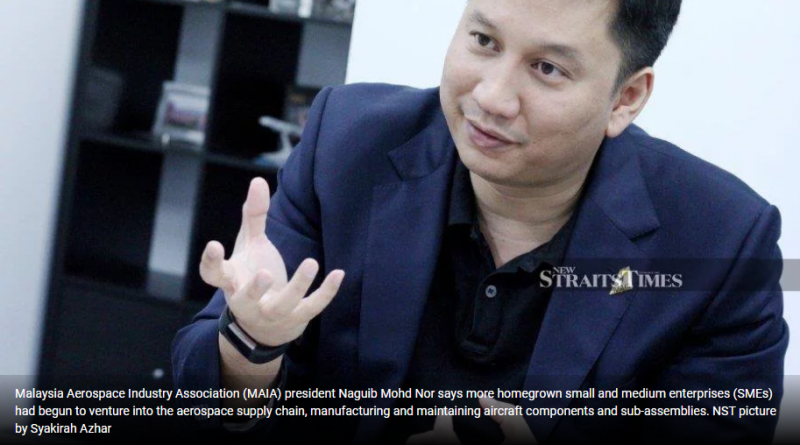Malaysia’s aerospace sector revenue can potentially rise by RM1bil annually
KUALA LUMPUR: The local aerospace industry is expected to record an average of RM500 million to RM1.0 billion increase in revenue annually.
This will be fuelled by the continued investments from both foreign and local companies in the supply chain network, supported by large aircraft backlog order books.
According to the National Aerospace Industry Coordinating Office (NAICO), revenue for Malaysia aerospace sector rose 6.67 per cent to RM14.4 billion recorded in 2018, from RM13.5 billion in 2017.
Malaysia Aerospace Industry Association (MAIA) president Naguib Mohd Nor said more homegrown small and medium enterprises (SMEs) had begun to venture into the aerospace supply chain, manufacturing and maintaining aircraft components and sub-assemblies.
“The aerospace sector delivers long-term earnings visibility for local players, particularly in the supply chain network for the original equipment manufacturers (OEMs) including Airbus and Boeing.
“This is because the sector gets between RM500 million and RM800 million investments annually from both foreign and local investors. Hence, there are ample opportunities to grow the aerospace supply chain network,” he told the New Straits Times in an interview recently.
Naguib said local SMEs could enhance their manufacturing and engineering capabilities to benefit from the OEMs’ burgeoning demand for aircraft parts and components but acknowledged that the capability barrier to entry was high.
“Local companies can take part in OEMs’ supply chain network to reap sustainable earnings due to longer contract periods. Aircraft designs do not change often unlike mobile phones for example.
“The aviation business is constantly growing. Nearly 80 per cent of the world population has still never flown in an aircraft. Hence, more aircraft will be needed, driving airlines to continue placing aircraft orders,” he added.
Naguib said the aerospace sector can be a lucrative business for local suppliers but they need to get certified and then approved by the OEMs to produce aircraft parts and components.
“Certification provides long-term earnings visibility in a high technology sector for the aerospace supply chain network, giving a steady cash flow for local suppliers,” he said.
With high-technology capability built through dealing with aerospace parts, Naguib said local manufactures can leverage and apply this expertise to other manufacturing sectors being disrupted by the 4th Industrial Revolution.
“Thus, local companies can diversify their high-tech skills not only in aircraft manufacturing but in other sectors that require this level of skill, competence and technology,” he said.
MAIA honorary secretary Datin Shelina Razaly Wahi said the aerospace industry was quite resilient, despite the downturn in the global economic and escalation of the trade war.
“OEMs like Airbus and Boeing still have large backlogs (of orders), which puts Malaysian aerospace companies in a good position, in terms of market outlook.
“Airlines are still placing substantial aircraft orders, and hence aerospace companies have a long-term commitment,” she said.
She added that the reason the aviation or airline industry was a resilient sector despite the usual cycles in the global economy, is due to aviation being a key enabler to global trade and business.
“It (stress) won’t be immediately felt in the aerospace manufacturing supply chain as the supply chain is dependent on orders from the respective OEMs to produce aircraft components, and is not dependent on consumer sentiment.
“For example – If an airline were to place an order for a new Airbus A320 aircraft, which is popular with low cost airlines, the waiting list could take up to seven years.
“Moreover, business still carries on and businessmen still have to travel. But perhaps they (passengers) will be more selective in choosing their carriers or class of travel, in order to reduce traveling cost,” she said.
She said local suppliers could also jump on the bandwagon by tapping into the growing demand for aircraft interiors manufacturing, for commercial aircraft.
“To adapt to consumer demands and preferences, there is now so much more product differentiation from Airlines, particularly when it comes to the aircraft interiors – such as seats, in-flight entertainment units, galleys, overhead bins and even toilets,” she said.
The government will need to consider providing more tailored incentives for the aerospace sector, which is geared towards the specific requirements of the potential and existing players in the country.
“Investors may require customised-incentives to support their specific requirements – whether their main drivers are based on their capital, land, utility or manpower costs. The incentives need to be looked upon at an ecosystem level but with clear returns calculated for the country” Naguib said.
Naguib said Malaysia would benefit from investors’ expansion activities, which in turn provide job opportunities to locals and exchange of expertise in high-value-added manufacturing capability.
“Aerospace is an economic enabler in context of the Fourth Industrial Revolution as it is an apex industry. It is a strategic industry in all developed countries and provides developing countries an opportunity to leapfrog into the high technology space, he said.
According to the global aerospace industry outlook, the world deliveries of aircraft are expected to require between 37,000 and 44,000 aircraft over the next 20 years by both Airbus and Boeing.
Additionally, new aerospace fields such as drone and air-mobility are beginning to gain traction.
Meanwhile, Malaysia’s aerospace manufacturing exports were projected to grow 15 per cent to RM9.75 billion this year from RM8.48 billion registered last year.
The sector currently employs over 24,000 Malaysians with 250 companies involved in the supply chain network.
International Trade and Industry Minister Datuk Darell Leiking reportedly said the country’s aerospace manufacturing sub-sector growth trajectory would be supported by the continued orders of aircraft components and add new products for aircraft sets.
Source: NST

